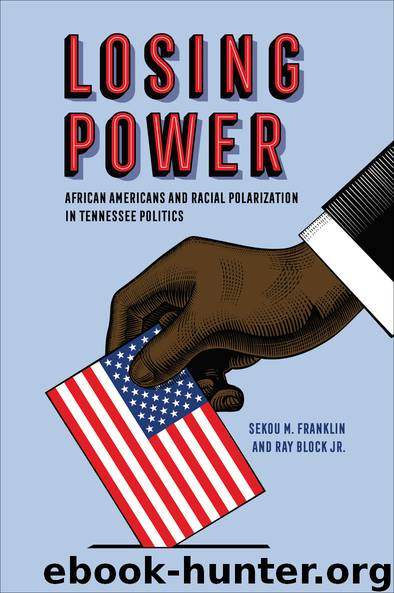Losing Power by Franklin Sekou M.;Block Ray;

Author:Franklin, Sekou M.;Block, Ray; [Неизв.]
Language: eng
Format: epub
Publisher: Lightning Source Inc. (Tier 3)
Published: 2020-03-26T20:00:00+00:00
OVERVIEW OF THE TENNCARE DEBATE, 1994–2006
Medicaid (Title XIX) was created in 1965 as health insurance for the poor. It was negotiated as a political compromise between President Lyndon Johnson and the American Medical Association. The latter clearly wanted to increase physicians’ ability to care for families with limited resources, and Johnson, seeking to bolster his appeal with voters, realized the importance of maintaining some of the momentum that the concept of a national health insurance program had gained as early as the Truman administration.25 However, as Jonathan Engel noted, Medicaid has at times been referred to as the “orphan” of the War on Poverty initiatives.26 The program was initially based on the medical vouchers that private insurance companies offered to poor people, but it quickly expanded into a robust insurance program.27
Blacks and other racial minorities were particularly supportive of Medicaid. Many lived in areas that lacked minority physicians and financially stable medical facilities.28 Racial minorities looked to Medicaid to address their substandard health care and systemic exclusion from established medical institutions. Rural residents also benefited from Medicaid. Many lived far away from health-care facilities, which contributed to their alienation from the medical profession.
When TennCare was first initiated in 1994, health-care practitioners and African American leaders celebrated the program because of its potential to expand coverage to hundreds of thousands of uninsured and chronically ill patients. The program was initially conceived as a managed-care program: participating insurance companies were converted into managed-care organizations. These organizations were paid lump sums, or what was referred to as “capitation fees,” to deliver and manage health care for thousands of patients.29 The potential benefit for state Medicaid programs that use managed-care systems is that if medical costs in a given month or year for a group of patients are more than the fees allocated to a participating insurance company, that company must absorb the additional costs. For example, if TennCare allocated $1 million per year to Blue Cross/Blue Shield to supervise health coverage for forty thousand patients, the insurance company would have to pay the balance of the medical costs for its patients if the costs exceeded the capitated amount that TennCare allotted.
Some of the people who pushed for improved health care in Tennessee believed that managed-care systems contained costs by forcing providers and insurance companies to focus attention on preventative services.30 Catastrophic illnesses, emergency room visits, and the overprescribing of drugs are common events for individuals who lack preventative care. These events add costs to Medicaid programs and can affix a financial burden to insurance companies. In theory, the potential risk of absorbing excessive medical costs encourages participating insurance companies to offer efficient services, disease management, and strict oversight of prescription drug use, all of which have the potential to stabilize costs and prevent Medicaid recipients from developing expensive medical conditions.
Within a few years of its implementation, TennCare expanded coverage to hundreds of thousands of working poor and chronically ill residents, people who otherwise would not have had any insurance. The state’s uninsured population
Download
This site does not store any files on its server. We only index and link to content provided by other sites. Please contact the content providers to delete copyright contents if any and email us, we'll remove relevant links or contents immediately.
| General | Discrimination & Racism |
Nudge - Improving Decisions about Health, Wealth, and Happiness by Thaler Sunstein(6629)
iGen by Jean M. Twenge(4693)
The Fire Next Time by James Baldwin(4336)
Adulting by Kelly Williams Brown(3663)
The Sports Rules Book by Human Kinetics(3581)
The Hacking of the American Mind by Robert H. Lustig(3575)
The Ethical Slut by Janet W. Hardy(3494)
Captivate by Vanessa Van Edwards(3292)
Mummy Knew by Lisa James(3164)
In a Sunburned Country by Bill Bryson(2941)
Ants Among Elephants by Sujatha Gidla(2920)
The Worm at the Core by Sheldon Solomon(2910)
Suicide: A Study in Sociology by Emile Durkheim(2606)
The Slow Fix: Solve Problems, Work Smarter, and Live Better In a World Addicted to Speed by Carl Honore(2570)
Humans of New York by Brandon Stanton(2376)
Handbook of Forensic Sociology and Psychology by Stephen J. Morewitz & Mark L. Goldstein(2376)
Blackwell Companion to Sociology, The by Judith R. Blau(2314)
The Happy Hooker by Xaviera Hollander(2272)
Outliers by Malcolm Gladwell(2254)
